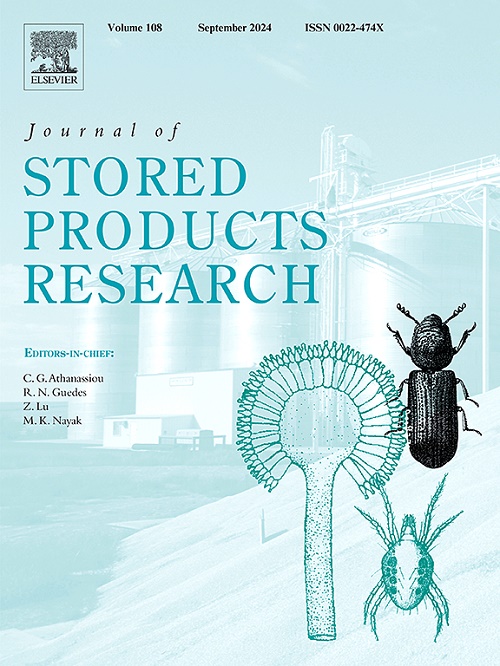Postharvest practices and aflatoxin content of cowpea (Vigna unguiculata L. Walp.) grain in Burkina Faso
IF 2.7
2区 农林科学
Q1 ENTOMOLOGY
引用次数: 0
Abstract
Cowpea is one of the most important crops in addressing food insecurity in less developed rural communities. However, due to certain inappropriate production and storage conditions, this crop is likely to be contaminated by fungi capable of producing mycotoxins. Hence, the objective of this study was to determine on post-harvest processing for cowpea grains in the three climatic zones, Sahelian, Sudano-Sahelian and Sudanian, of Burkina Faso and to assess the aflatoxin B1, B2, G1 and G2 content of these grains. A questionnaire was administered to 69 producers to determine the post-harvest processing methods of cowpea grain. The questionnaire was supported with direct observations. Post-harvest handling of cowpea grains by producers, predominantly female (74.4%), revealed that pod drying was on plastic sheets (39.13%), plastic bags (13.04%), terraces (36.23%), on the ground (4.35%), on the roof of sheds (4.35%) or on the roof of houses (2.9%). Whereas the main materials used for grain storage were sealed cans (49.28%) and Purdue Improved Crop Storage (PICS) bags (26.09%). Insects (36.23%) and fungi (10.14%) were the main biotic constraints reported. The aflatoxin contents of cowpea grain samples collected were relatively low (0.02 μg kg−1 to 2.56 μg kg−1) compared to the limit values set by the codex (0.5–15 μg kg−1) for foodstuffs. The study provides valuable insights into mycotoxin risks, offering guidance for regulatory measures. Its findings are applicable to other regions of Sub-Saharan Africa and developing areas, presenting practical solutions to enhance post-harvest management and address contamination challenges.
求助全文
约1分钟内获得全文
求助全文
来源期刊
CiteScore
5.70
自引率
18.50%
发文量
112
审稿时长
45 days
期刊介绍:
The Journal of Stored Products Research provides an international medium for the publication of both reviews and original results from laboratory and field studies on the preservation and safety of stored products, notably food stocks, covering storage-related problems from the producer through the supply chain to the consumer. Stored products are characterised by having relatively low moisture content and include raw and semi-processed foods, animal feedstuffs, and a range of other durable items, including materials such as clothing or museum artefacts.

 求助内容:
求助内容: 应助结果提醒方式:
应助结果提醒方式:


